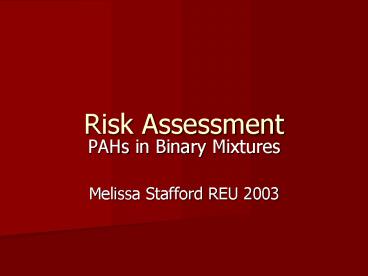Risk Assessment - PowerPoint PPT Presentation
1 / 17
Title:
Risk Assessment
Description:
Products of artificial and natural processes. Benzo(a)pyrene (BaP) Chrysene. 5-Methylchrysene ... 30 mM Benzo(a)Pyrene (BaP) - With S9 Rat Liver - Negative ... – PowerPoint PPT presentation
Number of Views:156
Avg rating:3.0/5.0
Title: Risk Assessment
1
Risk Assessment
- PAHs in Binary Mixtures
- Melissa Stafford REU 2003
2
Summary
- A Risk Assessment of PAHs in Binary Mixtures
- PAHs
- Toxicity
- Complex Mixtures
- Ames Assay
- Results and Conclusions
3
Polycyclic Aromatic Hydrocarbons - PAHs
- Potent animal Carcinogens
- Products of artificial and natural processes
Benzo(a)pyrene (BaP)
5-Methylchrysene
Chrysene
4
Natural Sources
Artificial Sources
Grilled Meat
Forest fires
Tobacco Smoke
Car Exhaust
Volcanic Eruptions
5
PAH Metabolism
Aromatic Hydrocarbon Receptor
6
PAH Metabolism
Tyrosine Kinase
7
PAH Metabolism
Cytochrome P450 - CYP1A1 -
BaP
BaP-7,8-diol-9,10epoxide
8
Mutations
G to T Transversion
9
Research Objectives
- To characterize the interactions of prevalent
mutagenic PAHs - Improve our understanding of complex mixtures of
PAHs in the environment.
10
Toxicity Assessments
1 1 2
Additive
EPA
?
Synergistic
Inhibition
1 1 0
1 1 5
11
Methods - The Ames Assay
U
Mutagen
Testor Strain
Histidine
Histidine
The more bacteria that live the higher the
mutagenicity!!
12
Ames Assay
- What to add
- Salmonella TA98
- Histidine and Biotin
- S9 rat liver
- Minimal Top Agar
- Chemical
13
Ames Assay - Results
Positive Control - 2-NitroFlourine -
783 revertants
30 mM Benzo(a)Pyrene (BaP) - With S9 Rat Liver -
Negative Control - BaP without S9 -
337 revertants
37 revertants
14
5-MethylChrysene/BaP Mixtures
- 25 reduction in net revertants
- 12.02 standard deviation between trials
- 30 reduction would be considered significant
15
Chrysene/BaP Mixtures
- 30 reduction in net revertants
- 96.87 standard deviation between trails
- Discrepancy probably due to degraded Chrysene
16
Conclusions
- The data show an overall additive trend
- The inhibition we found is at too insignificant a
level for the EPA to change current methods. - Data from this and GJIC will be plugged into QSAR
for calibration.
17
Acknowledgments
- I would like to thank
- Erica Reese for her undying patience and teaching
ability - Dr. Autenrieth for her guidance, understanding
and affection - Dr. Donnelly for the use of his lab and extensive
knowledge of the Ames Assay and PAHs.































